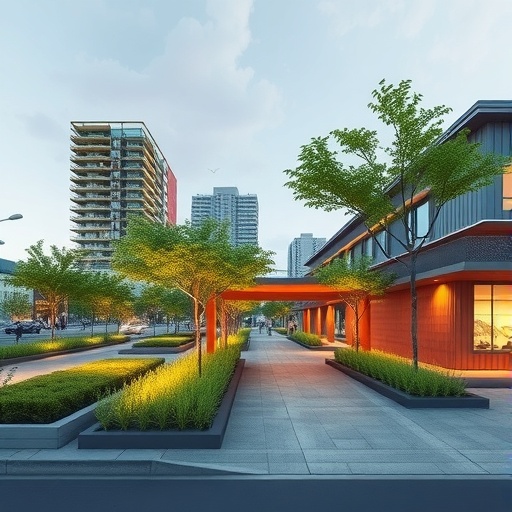In recent years, urban areas around the world have been facing significant challenges related to environmental sustainability, particularly as rapid urbanization continues to exert pressure on resources and ecosystems. A groundbreaking study led by researchers P. Madadi and M.R. Masnavi, published in “Discover Cities,” delves into the critical role of green infrastructure in urban planning, focusing on the specific case of Ghare-Kahriz in Arak, Iran. This research underscores the importance of integrating nature-based solutions within urban environments to foster eco-friendly cities capable of withstanding various ecological stresses.
The concept of green infrastructure refers to an interconnected network of green spaces, parks, waterways, and other natural components that enhance urban resilience while promoting biodiversity. Unlike traditional urban planning approaches that prioritize hard infrastructure, green infrastructure emphasizes the incorporation of natural elements into the urban fabric. This methodology aims to improve air quality, reduce urban heat island effects, and enhance water management systems. The study of Ghare-Kahriz provides valuable insights into how communities can utilize green infrastructure to achieve ecological and social benefits.
Ghare-Kahriz, a notable urban area in Iran, presents a unique context for analyzing urban green infrastructure networks. Rapid population growth and industrialization have led to environmental degradation, making it imperative for policymakers and urban planners to adopt innovative approaches to land use. The authors advocate for the re-evaluation of existing urban planning frameworks to incorporate eco-city principles that prioritize environmental health and community well-being. By studying Ghare-Kahriz, the researchers aim to illustrate how other urban centers can learn from its successes and challenges in implementing green infrastructure.
The research methodology employed by Madadi and Masnavi involved a comprehensive analysis of the existing urban fabric and its environmental parameters. This assessment included mapping current green spaces, evaluating biodiversity levels, and examining community engagement in environmental initiatives. Through this approach, the researchers were able to identify gaps in the urban landscape that could be filled with strategic green infrastructure investments, thus enhancing overall ecological resilience.
One of the pivotal findings of the research highlights the crucial role of public participation in the planning process. Engaging local communities in the design and implementation of green projects fosters a sense of ownership and responsibility toward maintaining these spaces. The study calls for a collaborative approach to urban planning where citizens, government agencies, and environmental organizations work hand in hand to create sustainable urban environments. Through participatory planning, the benefits of green infrastructure can be maximized for social well-being and environmental health.
Furthermore, the study emphasizes the necessity of a multi-disciplinary approach to urban green infrastructure. It suggests that incorporating insights from environmental science, urban ecology, landscape architecture, and sociology can lead to more effective green planning strategies. By combining expertise from various fields, urban planners can design innovative solutions that cater to the unique needs of their communities while leveraging the benefits of green spaces.
As urban areas increasingly grapple with climate change-related issues, the importance of green infrastructure cannot be overstated. The findings from Ghare-Kahriz reiterate that urban green spaces are not mere aesthetic additions but essential components of climate adaptation strategies. By enhancing urban biodiversity, improving air and water quality, and providing cooling effects, green infrastructure serves as a remedy for the detrimental impacts of urbanization. Thus, it is vital for cities to integrate these natural solutions into their planning frameworks.
Incorporating green infrastructure into urban areas also brings substantial economic benefits. By increasing property values, reducing healthcare costs associated with pollution, and fostering tourism through the creation of beautiful public spaces, cities can appreciate long-term financial returns. The study posits that investing in green infrastructure can yield significant dividends in terms of economic growth and quality of life improvements for local residents.
Moreover, the establishment of extensive networks of green spaces can promote active lifestyles and mental well-being for city dwellers. Access to parks and natural areas has been linked to improved physical health outcomes and reduced stress levels. The presence of diverse green environments can encourage community interaction and social cohesion, ultimately contributing to a more vibrant urban life. Ghare-Kahriz exemplifies how thoughtfully planned green infrastructure can transform urban landscapes into more livable and inviting environments.
Looking ahead, the case study of Ghare-Kahriz serves as a model for cities worldwide seeking to enhance their green infrastructure. Policymakers and urban planners can learn from its experiences, recognizing the importance of adaptive management strategies that can evolve in response to changing ecological dynamics. The research underlines the need for continuous monitoring and evaluation of green infrastructure initiatives to ensure their effectiveness and relevance in addressing urban environmental challenges.
The integration of technology into the planning process also emerges as an important consideration. Geographic Information Systems (GIS), remote sensing, and environmental modeling tools can aid in the analysis and visualization of green infrastructure opportunities. By employing cutting-edge technologies, planners can make informed decisions regarding the placement and design of green spaces, leading to more impactful urban interventions.
In conclusion, the research undertaken by Madadi and Masnavi sheds light on the vital intersection of urban planning, environmental sustainability, and community engagement. The case of Ghare-Kahriz in Arak, Iran, provides a compelling argument for prioritizing green infrastructure in the development of eco-cities. By adopting a holistic approach that considers ecological, social, and economic dimensions, cities can build a sustainable future that harmonizes human activities with nature. As urban centers continue to expand, the lessons learned from this study will become increasingly essential in shaping resilient, livable, and thriving urban environments for generations to come.
Subject of Research: Environmental planning of urban green infrastructure networks
Article Title: Environmental planning of urban green infrastructure networks in the eco-city framework, the case of Ghare-Kahriz Arak, Iran.
Article References:
Madadi, P., Masnavi, M.R. Environmental planning of urban green infrastructure networks in the eco-city framework, the case of Ghare-Kahriz Arak, Iran.
Discov Cities 2, 92 (2025). https://doi.org/10.1007/s44327-025-00136-5
Image Credits: AI Generated
DOI: https://doi.org/10.1007/s44327-025-00136-5
Keywords: Urban planning, green infrastructure, eco-cities, environmental sustainability, community engagement, biodiversity, urban resilience.




